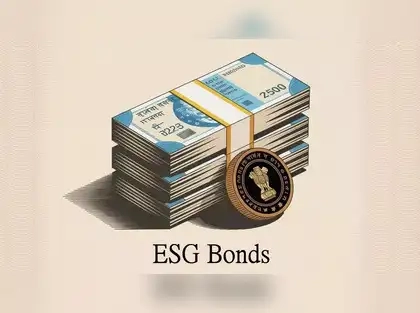 ETMarkets.com
ETMarkets.com India's ESG bond market is gaining traction, fueled by global investor interest and supportive regulations like SEBI's BRSR framework.
Synopsis
India's ESG bond market is gaining traction, driven by supportive regulations and rising investor interest in sustainable assets. Corporates, particularly in renewable energy and infrastructure, are increasingly utilizing ESG bonds for funding. While still nascent compared to global markets, the Indian ESG bond market is poised for significant growth, transforming fixed income investing.
Indias Environmental, Social, and Governance (ESG) bond market is steadily coming of age. Once seen as a niche segment, ESG and green bonds are now drawing increased interest from global investors, corporate issuers, and regulators alike.Tired of too many ads? Remove Ads
This evolving landscape is being shaped by supportive policies, a growing commitment to sustainability, and rising demand for impact-linked investments.
According to Vineet Agrawal, Co-Founder of Jiraaf, the momentum behind ESG bonds in India is unmistakable. "Rising global investor interest in sustainable assets, coupled with a progressive domestic regulatory environment, is helping this space grow," he says.Regulatory pushes like SEBIs Business Responsibility and Sustainability Reporting (BRSR) Core framework and the RBIs green finance guidelines are nudging Indian corporates to integrate ESG factors into their capital-raising strategies.
Tired of too many ads? Remove Ads
Sectors such as renewable energy, clean mobility, and infrastructure finance are already leading the way. A case in point: Larsen & Toubro (L&T) issued its first Rs 500 crore ESG bond recentlya significant move that signals the entry of Indias biggest conglomerates into sustainability-linked financing.


 "As ESG considerations become mainstream, more Indian corporates are expected to follow suit," adds Agrawal.While global markets have embraced ESG investingespecially in fixed incomeIndia is still finding its feet, says Gautam Kaul, Senior Fund Manager Fixed Income at Bandhan AMC. "In India, we are at an early stage of the ESG investing platform. The equity side is getting more traction, but fixed income is still nascent."However, the signals are encouraging. Private corporations and the Government of India have started issuing ESG and green bonds. The government's Sovereign Green Bonds (SGrBs) alone have raised close to Rs 57,697 crore through FY25.Yet, Kaul notes that domestic demand is limited, with foreign institutional investors currently dominating the buyer side of the market.
"As ESG considerations become mainstream, more Indian corporates are expected to follow suit," adds Agrawal.While global markets have embraced ESG investingespecially in fixed incomeIndia is still finding its feet, says Gautam Kaul, Senior Fund Manager Fixed Income at Bandhan AMC. "In India, we are at an early stage of the ESG investing platform. The equity side is getting more traction, but fixed income is still nascent."However, the signals are encouraging. Private corporations and the Government of India have started issuing ESG and green bonds. The government's Sovereign Green Bonds (SGrBs) alone have raised close to Rs 57,697 crore through FY25.Yet, Kaul notes that domestic demand is limited, with foreign institutional investors currently dominating the buyer side of the market.Kaul also touches on the pricing of ESG instruments. Is the market paying a significant premium for ESG bonds? Selectively, yes, he says. The greeniumor the yield differentialbetween green and regular government bonds is around 5 basis points. Its modest now, but could widen as the market matures.
The trajectory of Indias green bond market has been upward since 2017, following SEBIs introduction of formal green bond guidelines. This laid the groundwork for greater participation and accountability, says Nikhil Aggarwal, Founder and Group CEO of Grip.
Tired of too many ads? Remove Ads
He points out that globally, the green bond market not only scaled new highs in 2024 but also outperformed conventional bonds by nearly 2%.In India, the pace picked up further with the governments foray into green bond issuance. Institutional investorsmutual funds, banks, and insurersare increasingly aligning their portfolios with ESG objectives, spurred by both regulation and a broader shift toward sustainable investing.
"SEBIs strict disclosure and verification requirements add credibility, offering investors confidence that their money is driving genuine environmental and social impact," says Aggarwal.Aggarwal highlights several sectors that are particularly well-suited to tap into the growing ESG bond market:- Infrastructure & Urban Development: Projects like metro rail, highways, smart cities, and clean water are natural fits for sustainability-linked financing.
- Renewable Energy & Clean Tech: Solar, wind, hydro, and EV mobility companies directly support Indias net-zero goals and are key issuers of green bonds.
- Social Infrastructure: Affordable housing, hospitals, sanitation, and education projects provide clear social impact, making them ideal for social bonds.
- BFSI Sector: Banks and NBFCs with ESG frameworks can issue their own bonds or serve as conduits for channeling capital into green and social initiatives.
- Large Listed Corporates: The top 1,000 listed firms already complying with SEBIs BRSR norms are better positioned to meet ESG disclosure demands and raise funds via sustainability bonds.
 With climate commitments becoming non-negotiable and global capital increasingly prioritising sustainability, Indias ESG bond market is poised not just to growbut to transform the broader landscape of fixed income investing.
With climate commitments becoming non-negotiable and global capital increasingly prioritising sustainability, Indias ESG bond market is poised not just to growbut to transform the broader landscape of fixed income investing.( Disclaimer : Recommendations, suggestions, views and opinions given by the experts are their own. These do not represent the views of the Economic Times)




